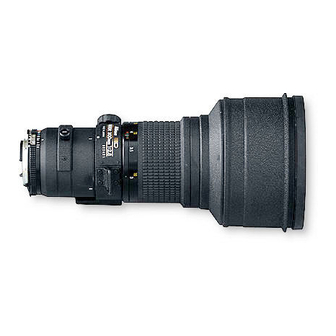Nikon AF-I Nikkor ED 300mm f/2.8D IF Instrukcja obsługi - Strona 18
Przeglądaj online lub pobierz pdf Instrukcja obsługi dla Obiektyw kamery Nikon AF-I Nikkor ED 300mm f/2.8D IF. Nikon AF-I Nikkor ED 300mm f/2.8D IF 39 stron.

Accessories
Slip-on leatherette front lens cap
Rear lens cap LF-1
39mm screw-in filter L37C
Holder for gelatine filters
Strap
Lens hood HK-19
Heavy duty case CT-304
Other 39mm screw-in filters
TeleconverterTC-14A*
TeleconverterTC-14B
Teleconverter TC-201 *
TeleconverterTC-30!
Autofocus Converter TC-16A*
* Slight vignetting may occur.
SPECIFICATIONS
Focal length: 300mm
Maximum aperture: f/2.8
Lens construction: 11 elements in 9 groups (plus dustproof glass plate built into front)
Picture angle: 8° 10'
Distance scale: Graduated in meters and feet from 2.5m (10 ft.) to infinity (°°)
Aperture scale: f/2.8—f/22 on both standard and aperture-direct-readout scales
Minimum aperture lock: Provided
Diaphragm: Fully automatic
Exposure measurement: Via full-aperture method with AI cameras or cameras with CPU interface system;
via stop-down method for other cameras
Focusing: Nikon Internal Focusing (IF) system
Tripod mounting: Built-in tripod mounting collar rotatable through 360°
Lens hood: Provided
Filters: Slip-in glass filter holder accepts 39mm screw-in filters; gelatine filter holder accepts gelatine filters
Mount: Nikon bayonet mount
Dimensions: Approx. 124mm (4.9 in.) dia. x 241mm (9.5 in.) extension from flange; approx. 250mm (9.8
in.) long (overall)
Weight: Approx. 2,950g (104 oz.)
LENS CARE
• Although you should always keep the lens surfaces clean, rough cleaning must be avoided. Wipe with a
soft, clean cotton cloth moistened with alcohol to remove grease or fingerprints from the lens surfaces.
If you use ether in cleaning the lens, a smudge sometimes appears on the surface of a multi-coated lens. If
this happens, wipe it again with a cotton cloth moistened with alcohol.
• Take care in cleaning the rear part of the lens with a spraygun-type blower because its strong stream of air
may damage the lens diaphragm blades. To avoid damage, set the lens at full aperture and use the blower
far enough away.
• Always protect the lens surface from dirt or damage. The lens hood also helps to protect the lens.
• Keep the lens cap in place whenever the lens is not in use.
• If you do not intend to use the lens for a long time, protect it from rust and mold by storing it in a cool,
dry place. Also, do not store in direct sunlight, and keep it away from naphthalene or camphor.
• Be careful not to get the lens wet or drop it in water. Water on the lens may cause malfunction.
16
